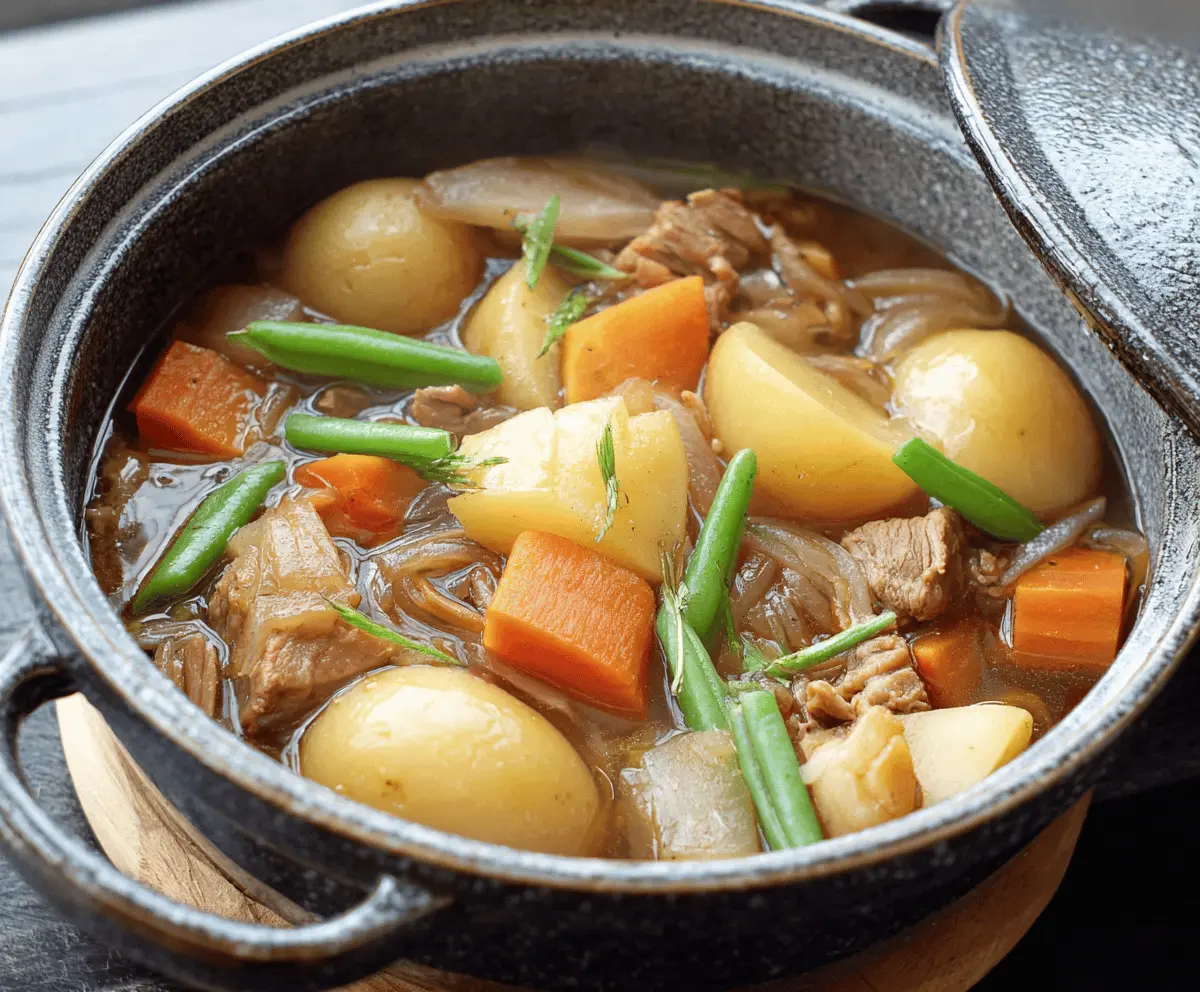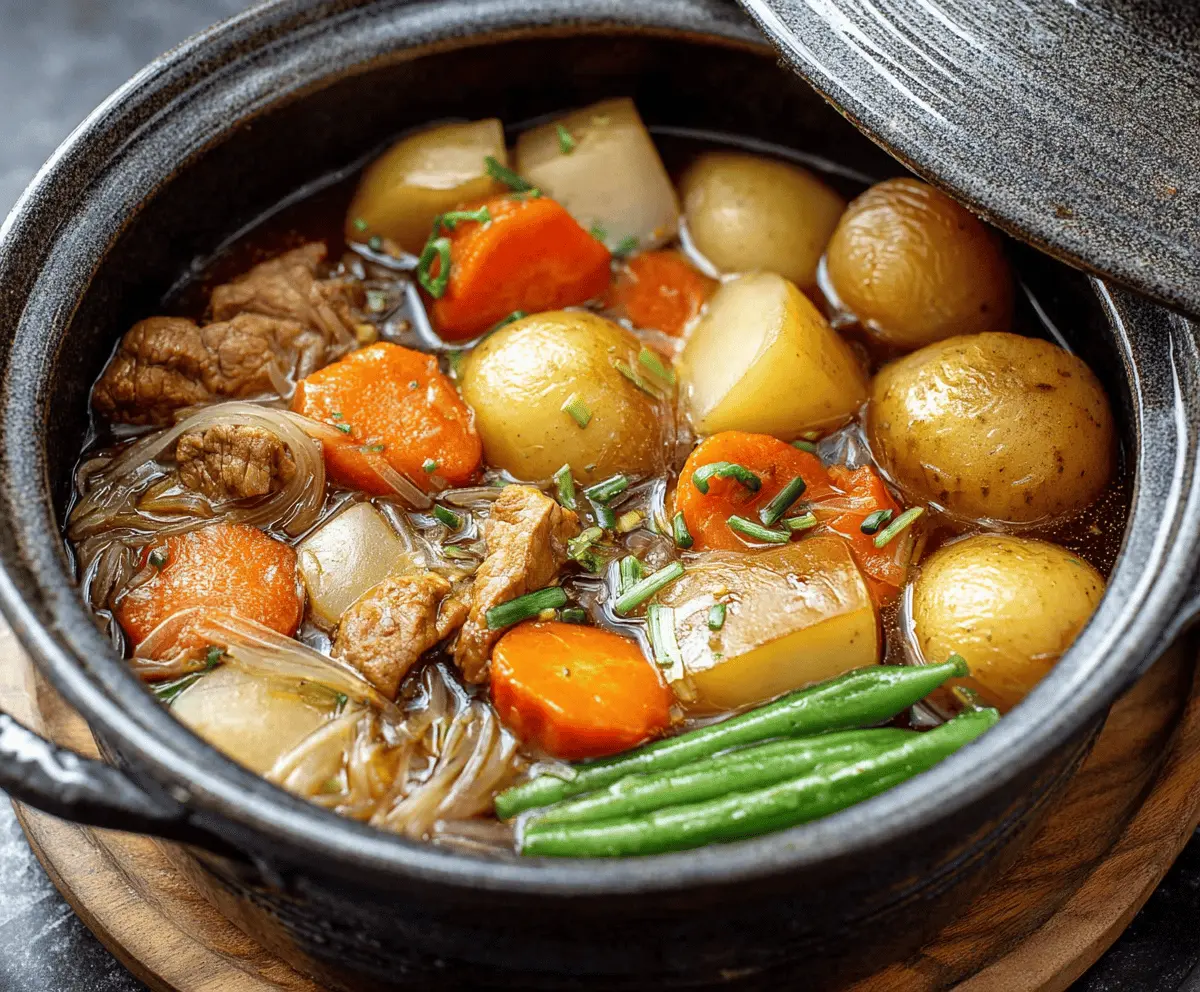Nikujaga is a warm and comforting Japanese dish made with tender meat, potatoes, and onions simmered in a sweet soy sauce broth. It’s like a hug in a bowl!
Cooking it all in one pot means less cleanup, which is a win! I love enjoying this dish with a side of rice; it’s perfect for a cozy dinner. Give it a try, you’ll find it hard to stop eating! 😊
Key Ingredients & Substitutions
Beef: Thinly sliced beef is essential for this dish’s flavor. I like using ribeye for its tenderness, but chuck works too. If you prefer a non-beef option, try sliced pork or tofu for a vegetarian twist.
Potatoes: Yellow potatoes hold their shape well during cooking. If you can’t find them, russet potatoes are a great substitute, but peel them beforehand since their skins are thicker.
Shirataki Noodles: These noodles are low in calories and add a unique texture. If they’re hard to find, you can use rice noodles or even regular egg noodles as an alternative.
Dashi Stock: Dashi enhances the umami flavor of Nikujaga. If you’re out of dashi, chicken or beef broth will work too. Just be sure to adjust the salt to taste since store-bought versions can vary.
How Do I Properly Caramelize the Onions?
Caramelizing onions adds sweetness and depth to the dish. Here’s the technique to get it just right:
- Slice your onions evenly for uniform cooking.
- Start by heating the oil in the pot over medium heat.
- Add the onions and cook, stirring frequently for about 5-7 minutes, until they become golden brown and fragrant.
- Keep the heat moderate to avoid burning; if they start to brown too quickly, lower the heat.
Perfectly caramelized onions will bring a wonderful richness to your Nikujaga, enhancing the overall flavor!

One Pot Japanese Nikujaga
Ingredients You’ll Need:
For the Main Dish:
- 1 lb (450 g) thinly sliced beef (such as ribeye or chuck)
- 4 medium yellow potatoes, peeled and cut into large chunks
- 2 medium carrots, peeled and sliced into thick rounds
- 1 large onion, peeled and cut into large wedges
- 4 oz (120 g) shirataki noodles (konnyaku noodles), rinsed and cut into shorter pieces
- 1 cup green beans, trimmed (for garnish)
For the Broth:
- 2 cups dashi stock (or substitute with beef/chicken broth)
- 4 tablespoons soy sauce
- 3 tablespoons mirin (sweet rice wine)
- 2 tablespoons sake (Japanese rice wine)
- 1 tablespoon sugar
Miscellaneous:
- 1 tablespoon vegetable oil
- Chopped green onions or chives for garnish (optional)
How Much Time Will You Need?
This delicious dish takes about 10 minutes to prep and 30-35 minutes to cook. Just one pot for a hearty meal, plus a little simmering time for those wonderful flavors to come together!
Step-by-Step Instructions:
1. Heat the Oil:
Start by heating the vegetable oil in a large pot or deep skillet over medium heat. This will create a base for browning your beef and adding flavor.
2. Cook the Beef:
Add the sliced beef to the pot and cook it until it is just browned. You don’t want it fully cooked yet; this will happen later. Once it’s browned, remove the beef from the pot and set it aside.
3. Sauté the Onion:
In the same pot (don’t wipe it out!), add the onion wedges. Sauté them for about 3 minutes until they start to soften and become fragrant.
4. Add the Vegetables:
Next, toss in the potatoes, carrots, and shirataki noodles. Stir everything together so the veggies are well mixed with the onions.
5. Combine Everything:
Return the beef to the pot, making sure to mix it in with the veggies. This step makes sure all the meat flavor blends with the vegetables.
6. Prepare the Broth:
Pour in the dashi stock, then add the soy sauce, mirin, sake, and sugar to the pot. Give everything a gentle stir to combine. This mixture will create a tasty broth!
7. Simmer and Cook:
Bring the mixture to a boil, then lower the heat, cover with a lid, and let it simmer for about 20-30 minutes. You want the potatoes and carrots to become tender.
8. Blanch the Green Beans:
While the stew is simmering, prepare the green beans. Blanch them in boiling water for 2-3 minutes until they turn bright green and are just tender. Then drain and set aside.
9. Finish the Stew:
When the stew is done cooking and the vegetables are tender, add the blanched green beans to the top. Let everything warm through for a minute or two.
10. Serve It Up:
Now you’re ready to enjoy your Nikujaga! Serve it hot, garnished with chopped green onions or chives if you like. It’s perfect with a bowl of steamed white rice on the side.
Enjoy the comforting flavors of this classic Japanese home-cooked dish!
Can I Use Different Vegetables in Nikujaga?
Absolutely! While traditional Nikujaga includes potatoes and carrots, you can add other vegetables like daikon radish, mushrooms, or bell peppers for extra flavor and nutrients. Just consider their cooking times so they do not become too soft.
Can I Make Nikujaga in Advance?
Yes, you can! Nikujaga actually tastes better the next day as the flavors meld. After cooking, let it cool to room temperature, then store it in an airtight container in the fridge for up to 2-3 days. Reheat on the stove or in the microwave before serving.
What Are the Best Ways to Store Leftover Nikujaga?
Store leftovers in an airtight container in the refrigerator for up to 3 days. For longer storage, you can freeze it in freezer-safe containers, where it will keep for about 1-2 months. Thaw in the fridge overnight before reheating.
Is It Possible to Make Nikujaga Vegetarian?
Definitely! You can replace the beef with tofu or tempeh for protein. Use vegetable broth instead of dashi, and adjust the seasonings to ensure the dish remains savory and tasty. The combination of sweetness from the mirin and soy sauce will still shine through!
